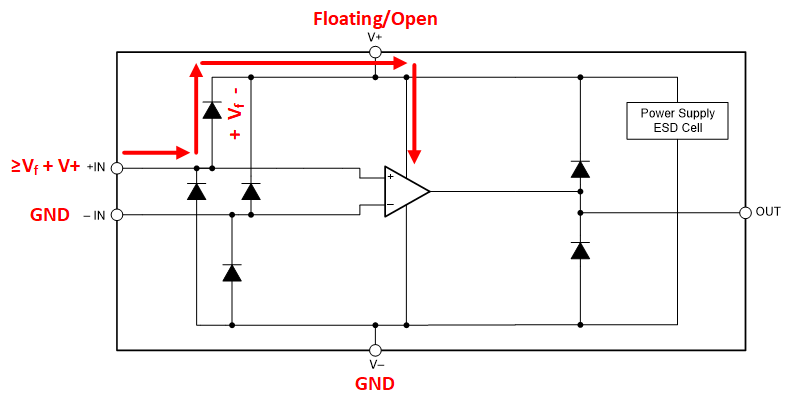SLVAEX7A December 2020 – January 2023 OPA2310 , OPA310 , OPA348 , OPA4310 , TLV341 , TLV341A , TLV342 , TLV342A
2.2 Standard Op Amp ESD Protection: Considerations
The TLV9051 device has the traditional ESD diode protection shown in Figure 2-2. For certain applications, such as a battery-powered system, the circuit designer can choose to save power by temporarily turning off the amplifier. This is usually done by either floating V+ or, preferably, setting V+ to ground. When the amplifier is turned off, the input can continue to detect a voltage, such as a signal being generated by a sensor.
 Figure 2-2 Input Current Path of a
Back-Powered Op Amp
Figure 2-2 Input Current Path of a
Back-Powered Op AmpWhen V+ is high impedance or floating, there exists the possibility of back-powering the amplifier. Back-powering can happen when the input experiences a voltage greater than the forward voltage of the ESD diode plus the voltage at the V+ rail, then the diode can begin to conduct current through the input to the supply pin. If the V+ pin is not being driven, the voltage can float up, especially if there is an impedance to ground at this node from another section of the circuit. The device is then turned on using the input signal as a means to power on the amplifier through the ESD diode. The output of the amplifier begins to provide undesired output signals, which can then feed to downstream components. A similar scenario can occur in a sensor circuit when the sensor turns on and sends a signal that reaches the inputs of the amplifier before the supply pins of the amplifier have fully ramped.
One way to help protect against accidentally back-powering the device is not to leave the V+ pin floating. When the pin is left floating or open, the voltage of the pin is unpredictable and it can be impossible to tell when the protection diode to V+, or even to V–, is likely to turn on. By grounding this pin, the circuit designer can help prevent the voltage of the V+ pin from floating upward and turning on the amplifier.
Even if grounding the V+ pin prevents the amplifier from being back-powered, in such a scenario, there still exists the possibility of unwanted current going into the diode. The input protection diode to V+ can still be turned on if the input voltage is higher than GND by the forward voltage drop of the protection diode. The best way to prevent back-powering of the amplifier in the presence of an input signal when V+ is left floating or grounded, is to avoid turning on the ESD diodes entirely. For cases when an input voltage is unavoidable while the supply pins of the amplifier are grounded or left floating, an alternate ESD protection scheme is needed.